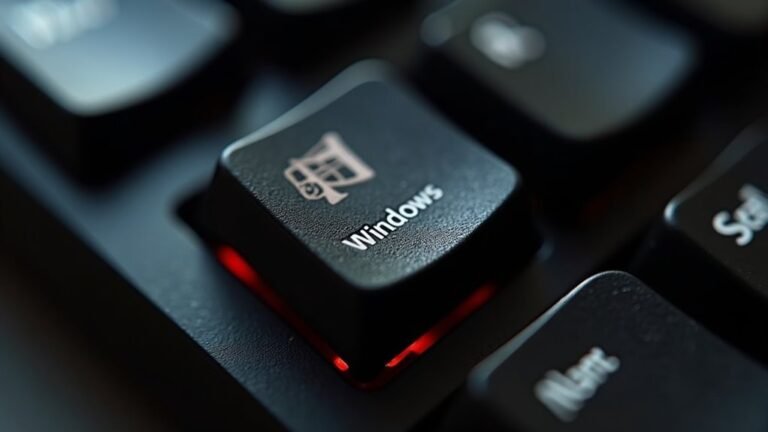Windows Error Worm: Fix Malware System Corruption

If you’ve been hit by a Windows error worm, you’re dealing with aggressive malware that exploits system flaws to corrupt files and destabilize your OS. Start by disconnecting your device from the network.
Boot into Safe Mode and terminate suspicious processes. Then, scan thoroughly with a reputable antivirus.
Delete discovered worm files and review startup entries. Patch your system and strengthen firewalls to prevent reinfection.
To fully secure your Windows system and prevent future attacks, there’s much more you need to apply.
Understanding What a Windows Error Worm Is

What Is a Windows Error Worm and How Does It Impact Your Network?
A Windows error worm is a type of malicious software that self-replicates by exploiting vulnerabilities in Windows operating systems, spreading rapidly across your network without any user interaction. Unlike traditional viruses, Windows worms don’t require you to open files or click links; they automatically exploit security flaws in protocols such as SMB (Server Message Block) or weaknesses caused by Windows misconfigurations.
These worms can infiltrate your entire network autonomously, making them especially dangerous. In addition to network propagation, Windows error worms spread through phishing emails, compromised file shares, instant messaging platforms, and removable USB drives.
A key characteristic that sets these worms apart from other forms of malware is their ability to self-replicate without human intervention, allowing them to move from one device to another once they have been activated.
Once a worm infects your system, it can deploy harmful payloads including ransomware, spyware, or backdoors, which jeopardize system integrity and compromise sensitive data. Infected devices often experience high bandwidth consumption and degraded performance, leading to instability on endpoints and servers.
Famous Windows worms like WannaCry and Conficker illustrate how quickly these threats can disrupt business operations by crippling infrastructure, disabling security measures, and enabling secondary cyberattacks.
To protect your Windows environment from error worms, it’s critical to regularly patch operating system vulnerabilities, strengthen network protocols, and control the use of external devices.
Common Signs Your System Is Infected
Common Signs Your System Is Infected with Windows Error Worms
Understanding how Windows error worms operate is crucial to protecting your network from serious threats. To safeguard your system, it’s important to recognize the early warning signs of infection and take prompt action. Key indicators include sudden performance issues such as slow startups, lagging applications, and unusually high CPU or disk usage. These symptoms often point to resource-intensive malware like crypto miners or botnets draining your system’s power.
Be alert for frequent pop-up ads, browser hijacking, unauthorized redirects, and unknown toolbars appearing in your web browser. If you find yourself locked out of system settings, unable to run security software, or notice that Windows Defender and update services are disabled, these are strong signs of an active worm infection disrupting your security measures.
Additional red flags include new, unfamiliar programs or desktop icons, missing or corrupted files, and unauthorized changes to system configurations. If your email or social media accounts send messages without your consent, your system may be compromised.
Hardware issues such as overheating, continuous fan noise, and rapid battery drain can also indicate hidden malware running in the background. Frequent computer crashes and unexpected shutdowns are also symptoms that may point to a deeper infection affecting your operating system’s stability.
To respond effectively, immediately disconnect your device from the internet and network to prevent further spread. Run a full system scan using updated antivirus or anti-malware tools to detect and remove threats. Document all unusual activities and symptoms to assist in incident response and recovery.
How Worms Impact Windows Stability and Security
How Worms Affect Windows Stability and Security: Key Risks and Protection Strategies
Windows error worms present a serious threat to system stability and security, going beyond simple application disruptions to impact entire networks. When a worm infects your Windows system, it rapidly consumes CPU and memory resources, causing significant slowdowns, system freezes, and frequent crashes.
These self-replicating worms overwhelm critical processes, while excessive network traffic generated during propagation degrades both local and remote connectivity.
In addition to performance issues, Windows worms jeopardize data integrity by corrupting or deleting files, stealing sensitive information, and even deploying ransomware that encrypts data and demands payment.
Infected devices can also become part of botnets, which facilitate Distributed Denial of Service (DDoS) attacks and enable further worm spread across your network.
Modern Windows worms often use advanced techniques like polymorphic code and multiple infection vectors, making traditional antivirus software insufficient for complete protection.
To safeguard your Windows environment, it’s essential to implement layered security measures including robust endpoint protection, strategic network segmentation, continuous system monitoring, and comprehensive user education.
These steps help minimize worm exposure, reduce recovery costs, and maintain overall Windows system stability and security.
Recognizing Key Symptoms of Worm Infection

Recognizing Key Symptoms of Worm Infection: Early Warning Signs to Protect Your System
Worm infections can rapidly compromise your computer system, making it crucial to identify their key symptoms early to minimize damage and stop further spread.
Watch out for frequent, unexplained system shutdowns or restarts, especially if error messages mention critical services like Remote Procedure Call (RPC). Be alert for stop errors (Blue Screens) on older or legacy systems, or unexpected Windows prompts asking you to report errors.
Check your system directories for suspicious files such as Msblast.exe or Win32sockdrv.dll, which are common indicators of worm infections.
Network issues like sudden congestion, slow responses from domain controllers, or blocked access to security websites often signal malicious activity. If your security software, system updates, or utilities become disabled or unresponsive, this could be a sign of infection.
Monitor your web browser for unauthorized homepage changes, persistent redirects, or unfamiliar extensions that may have been installed without your consent.
Performance issues such as unexplained storage consumption, new desktop icons or shortcuts, and frequent error messages are also red flags. Additionally, watch for unusual email activity, like suspicious emails sent from your account.
Early detection of worm infection symptoms is essential for swift containment and effective remediation.
Follow these guidelines to protect your computer and network from worm threats and maintain optimal security.
Detecting and Identifying Worm Activity
Detecting and Identifying Worm Activity: Effective Strategies for Windows Error Worms
Worm infections can spread rapidly, making early detection and accurate identification essential to stop propagation and limit damage. To effectively detect a Windows Error Worm, use a multi-layered detection strategy combining signature-based methods for known threats with anomaly-based detection to uncover new or zero-day worm variants.
Key behavioral indicators to monitor include random or sequential IP scanning, high volumes of similar network packets, and unusual spikes in bandwidth usage—these are strong signs of active worm propagation.
Implement real-time packet inspection and advanced statistical network analysis to identify early-stage worm infections quickly. On host systems, watch for unusual signs such as unexpected new processes, unauthorized modifications to files, spikes in CPU or memory usage, and programs launching automatically without user consent—all common indicators of worm activity.
Deploy honeypots strategically to attract worm attempts, allowing identification and containment before these threats reach critical production systems. Enhance detection accuracy by correlating alerts from multiple sensors, which helps reduce false positives.
Use behavioral heuristics to detect rapid scanning behavior or suspicious file propagation patterns effectively. Stay vigilant because worms often use encryption or obfuscation techniques to evade detection. Continuous tuning and updating of your security defenses are crucial to maintaining robust protection against evolving worm threats.
Steps to Remove a Windows Error Worm
How to Remove a Windows Error Worm: Step-by-Step Guide
If you have detected a Windows Error Worm infection on your PC, it’s crucial to act quickly to contain and remove the threat. Follow these effective steps to eliminate the Windows Error Worm and secure your system:
1. Terminate Windows Error Worm Processes
Start by opening Task Manager or Process Explorer to identify and end suspicious processes related to the worm. For persistent processes that won’t close, use RKill, a specialized tool designed to stop malware processes safely.
2. Boot Your PC into Safe Mode
Restart your computer in Safe Mode. This prevents the worm from automatically restarting and helps you safely perform removal tasks without interference.
3. Remove Worm Startup Entries from the Registry
Access the Windows Registry Editor and navigate to the following keys:
- HKEY_CURRENT_USERSoftwareMicrosoftWindowsCurrentVersionRun
- HKEY_LOCAL_MACHINESOFTWAREMicrosoftWindowsCurrentVersionRun
Look for any entries linked to the Windows Error Worm, such as malicious rundll32 references or executable files, and delete them. Using tools like Autoruns can make identifying and managing startup items easier.
4. Delete All Worm-Related Files
Enable viewing of hidden and system files on all drives. Manually locate and remove all worm executables and Autorun.inf files left behind. This step ensures no remnants remain to reinfect your system.
5. Perform a Full System Scan with Antivirus Software
Run a comprehensive scan using reputable antivirus and malware removal tools. Quarantine or delete all detected threats. After cleaning, perform a second scan to confirm that the Windows Error Worm is completely removed.
6. Restore System Settings and Update Security
After removal, reset any changed system settings to default. Install the latest Windows updates and security patches to protect your PC from future infections. Finally, change all your passwords as a precaution against potential data compromise.
Essential Tools for Malware Detection and Cleanup

Essential Tools for Effective Malware Detection and Cleanup on Windows Systems
After successfully removing a Windows Error Worm, the next crucial step is to validate your system’s integrity and detect any remaining malware traces. Utilize powerful static analysis tools such as PeStudio, CFF Explorer, and PE-bear to thoroughly analyze executable files. These tools help identify suspicious imports, entropy anomalies, and packer signatures that indicate potential obfuscation or malicious behavior.
Enhance your malware detection by leveraging VirusTotal, a comprehensive online service that cross-references files against multiple antivirus engines to identify known threats quickly. To uncover persistence mechanisms used by worms, employ Autoruns, which enumerates all auto-start entries and helps detect hidden startup processes that malware may exploit.
Dynamic analysis tools provide deeper insight into malware behavior. Use x64dbg and Process Monitor to trace system calls and monitor real-time process activities, revealing hidden malicious operations. Process Hacker is invaluable for spotting unusual resource consumption, aiding in the identification of active threats.
For advanced behavioral analysis, deploy sandbox environments like Cuckoo Sandbox and Noriben, which safely execute suspicious files in isolated settings to capture detailed malware footprints without risking your host system.
Address memory-resident malware with DumpIt.exe for memory acquisition. Follow up with forensic analysis using Volatility, Rekall, or Redline to extract critical artifacts and detect rootkits or stealth threats within system memory.
For comprehensive reverse engineering and code inspection, integrate advanced tools such as Ghidra or IDA Pro, enabling thorough validation and understanding of malware functionality.
Preventing Future Worm Infections
How to Prevent Future Worm Infections on Windows: A Comprehensive Security Guide
Preventing future worm infections on Windows requires a strong, multi-layered defense strategy to safeguard your network and systems effectively.
Start by enhancing your network security: configure firewalls to block unauthorized access and filter suspicious traffic, and implement Access Control Lists (ACLs) on routers and switches to control packet flow according to your security policies.
Use TCP Wrappers or similar tools with ACLs to manage network service access and maintain detailed logging. Always encrypt all network communications, including SSH and FTP, and use VPNs on unsecured Wi-Fi networks to prevent data interception and worm propagation.
Next, maintain up-to-date system and software management by applying patches promptly and enabling automatic updates.
Remove unused services to reduce potential attack surfaces. Enforce strong authentication practices by requiring complex, unique passwords and implementing multi-factor authentication (MFA).
Apply the principle of least privilege to user accounts and continuously monitor account activities to detect any suspicious behavior.
Finally, protect your critical data by performing regular encrypted backups stored in isolated locations.
Utilize data loss prevention (DLP) tools to monitor and safeguard sensitive information, ensuring your data remains secure even in the event of a worm infection.
Best Practices for Securing Your Windows System
Best Practices for Securing Your Windows System: A Comprehensive Guide
Windows security is critical in protecting your system from cyber threats and vulnerabilities. Attackers often exploit misconfigurations and unpatched flaws, making it essential to follow best practices for Windows system security. Here’s how to safeguard your Windows environment effectively:
1. Keep Your Windows System Updated
Ensure your Windows operating system is always up to date by promptly applying critical and recommended updates.
Enable automatic updates through Windows Update to receive patches as soon as they’re released. Regularly reboot your system to ensure updates are fully applied and effective. Always use official Windows Update channels to avoid installing compromised or unverified patches.
2. Enforce the Principle of Least Privilege
Limit user permissions by granting only the necessary rights for their roles.
Disable or rename default administrator accounts to reduce attack surfaces. Implement strong, complex passwords on all accounts and remove guest and anonymous users to enhance security.
3. Strengthen Network Security
Restrict network access to authenticated users only and deploy multifactor authentication (MFA) wherever possible to add an extra layer of protection.
Activate Windows Firewall to monitor and control incoming and outgoing traffic. Disable unnecessary services such as Remote Desktop Protocol (RDP) and file/print sharing if they aren’t in use.
4. Deploy Advanced Antivirus and Antimalware Solutions
Use enterprise-grade antivirus and antimalware software with real-time updates to detect and prevent threats.
Complement these tools with Windows Defender Application Control to whitelist trusted applications, ensuring only authorized software runs on your system.
5. Harden System Security Settings
Enable kernel memory integrity and virtualization-based security features in Windows to protect against advanced threats.
Run user accounts with standard privileges instead of administrative rights to minimize risk exposure.
6. Protect Sensitive Data with Encryption
Utilize BitLocker encryption to secure sensitive data on your drives.
Implement strict key management policies and control the use of removable media to prevent unauthorized data access or leakage.
7. Enforce Strong Authentication Protocols
Use strong Kerberos encryption to secure authentication processes within your network, reducing the risk of credential theft and unauthorized access.
By following these Windows security best practices, you can significantly reduce vulnerabilities and protect your system from cyberattacks.
Stay proactive with updates, enforce strict access controls, and leverage built-in Windows security features for optimal protection.
For more Windows security tips and updates, visit the official Microsoft Windows Security Center or trusted cybersecurity resources.
Frequently Asked Questions
Can Windows Error Worms Infect Other Operating Systems Like Macos or Linux?
You don’t need to worry about Windows error worms infecting macOS or Linux directly; they’re designed for Windows vulnerabilities. Still, always patch your systems, restrict unnecessary protocols, and monitor network traffic to limit cross-platform malware threats.
Are Windows Error Worms Capable of Stealing Personal Data or Credentials?
Absolutely, you should know Windows error worms can steal personal data and credentials. They exploit system vulnerabilities, deploy keyloggers, and harvest passwords. Immediately update software, run reputable antivirus scans, and change compromised credentials to mitigate ongoing threats and data loss.
Do Hardware Upgrades Help Recover From Worm-Induced Performance Issues?
You’ll notice improved system responsiveness and stability after hardware upgrades, as faster processors and more memory counteract worm-induced slowdowns. However, you must still remove the worm, since upgraded hardware alone won’t eliminate the underlying malware threat.
Is It Safe to Use Online Banking After Worm Removal?
It’s not fully safe to use online banking right after worm removal. You should verify complete malware eradication with multiple scans, check system integrity, update security measures, and only access banking sites on a clean, trusted device.
Can System Recovery Tools Undo All Changes Made by Worms?
System recovery tools can’t always undo all changes made by worms. You risk hidden infections, altered settings, or compromised restore points. For thorough remediation, combine advanced recovery tools, repeated scans, and manual review of files, registry, and system settings.
Conclusion
Think of a Windows error worm like a leak in your system’s hull—ignore it, and your whole ship could sink. You’ve learned to spot the warning signs, use the right tools, and patch vulnerabilities. Stay vigilant by updating software, running regular scans, and practicing smart browsing habits. If you act swiftly and decisively, you’ll keep your system secure and resilient, preventing future malware breaches from turning minor threats into major security disasters.





